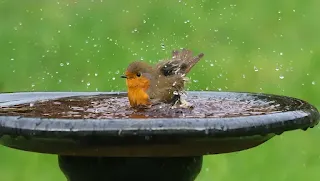How to Provide the Right Temperature for Your Exotic Bird
Exotic birds are captivating pets, known for their vibrant colors, playful personalities, and enchanting songs. However, these tropical companions come from climates vastly different from many human homes. Maintaining the right temperature is crucial to their health and well-being. Whether you’re caring for a parrot, cockatiel, or finch, understanding and controlling the temperature of their environment can mean the difference between thriving and surviving.
In this guide, we’ll explore the importance of temperature for exotic birds, how to create the ideal environment, and tips to ensure they remain comfortable throughout the year.
Why Temperature Matters for Exotic Birds
Exotic birds originate from regions with stable and warm climates, such as rainforests and savannas. These environments provide consistent temperatures that support their unique physiological needs. When brought into homes, birds can become stressed by fluctuating or extreme temperatures, which can lead to:
Health Issues: Cold temperatures can suppress the immune system, making birds susceptible to respiratory infections.
Stress and Behavioral Changes: Uncomfortable birds may become lethargic, irritable, or stop eating.
Feather Problems: Birds in poor temperature conditions may over-preen, pluck feathers, or develop dull plumage.
Creating a temperature-stable environment is a critical part of responsible bird ownership.
Understanding the Ideal Temperature Range
Tropical Parrots: Prefer warmer temperatures closer to 80 degrees.
Cockatiels and Budgerigars: Comfortable around 70-75 degrees.
Finches and Canaries: Do well in slightly cooler ranges but still above 65 degrees.
Signs Your Bird is Too Cold
Fluffed-up feathers (to trap heat).
Shivering or trembling.
Lethargy and reluctance to move.
Signs Your Bird is Too Hot
Panting or breathing with an open beak.
Holding wings away from the body.
Restlessness and irritability.
Monitoring these signs can help you adjust their environment accordingly.
Setting Up the Ideal Environment
Choosing the Right Location
The placement of your bird’s cage plays a significant role in temperature regulation:
Avoid Drafts: Keep cages away from windows, doors, and air vents.
Sunlight Considerations: Ensure direct sunlight doesn’t overheat the cage during the day.
Stable Areas: Choose a spot where temperatures remain consistent throughout the day.
Using Thermometers
Place thermometers near the bird’s cage to monitor the ambient temperature. Digital models with humidity readings are particularly helpful for ensuring a balanced environment.
Heating Solutions for Cold Climates
Heat Lamps
Designed specifically for birds, heat lamps provide focused warmth without emitting harmful light or noise.
Place the lamp outside the cage to avoid accidental burns.
Heating Pads
Attach heating pads to the outside of the cage or beneath a solid surface tray.
Use only models designed for pets to ensure safety.
Room Heaters
Space heaters can warm the entire room but must be used with caution to avoid overheating.
Choose models with safety features like automatic shut-off and ensure proper ventilation.
Insulation
Cover the cage partially with a breathable cover at night to retain warmth.
Avoid complete coverage to maintain airflow.
Cooling Strategies for Hot Climates
Exotic birds can also struggle with excessive heat, particularly during summer months. Overheating can be as dangerous as being too cold. Here’s how to keep your bird cool:
Air Conditioning
Maintain a consistent room temperature using air conditioning.
Avoid directing airflow straight at the cage to prevent drafts.
Fans
Use fans to circulate air gently.
Position them to create indirect airflow, ensuring your bird isn’t directly exposed.
Misting
Lightly mist your bird with water to mimic natural rain and help cool them down.
Use lukewarm water to prevent shock.
Shade
Provide shaded areas in the cage where your bird can retreat from bright sunlight.
Use cage covers or nearby plants for natural shading.
Maintaining Humidity Levels
How to Increase Humidity
Humidifiers: Place a humidifier in the bird’s room to maintain appropriate moisture levels.
Indoor Plants: Add potted plants to the room to naturally boost humidity.
Showers: Let your bird enjoy time in the bathroom while you run a warm shower to create steam.
How to Decrease Humidity
Use a dehumidifier if levels exceed 70%.
Improve room ventilation with fans or open windows.
Travel and Temperature Regulation
When traveling with your exotic bird, maintaining a comfortable temperature is essential:
Use insulated travel carriers to protect your bird from drafts and temperature extremes.
Avoid leaving your bird in parked cars, where temperatures can become dangerous quickly.
Plan breaks during long trips to monitor and adjust your bird’s environment.
Special Considerations for Young and Sick Birds
Brooders for Chicks: Maintain temperatures between 85-95 degrees Fahrenheit, gradually reducing as they mature.
Sick Birds: Consult your veterinarian for specific temperature recommendations and consider using heating pads or lamps to support recovery.
Common Myths About Temperature and Birds
Myth: “Birds can adapt to any temperature.”
Fact: Exotic birds are sensitive to temperature changes and can’t easily adapt to extremes.
Myth: “Cage covers are enough to keep birds warm.”
Fact: While helpful, cage covers may not provide sufficient warmth in colder climates.
Myth: “Fans are dangerous for birds.”
Fact: When used correctly, fans can safely circulate air without harming birds.
Monitoring Your Bird’s Comfort
Final Thoughts
Providing the right temperature for your exotic bird is a vital part of their care. By understanding their specific needs, setting up a stable environment, and making seasonal adjustments, you can ensure they lead a comfortable and vibrant life. Your bird’s health and happiness depend on your dedication to creating the ideal habitat, so invest the time and effort to make their environment as welcoming as possible.








